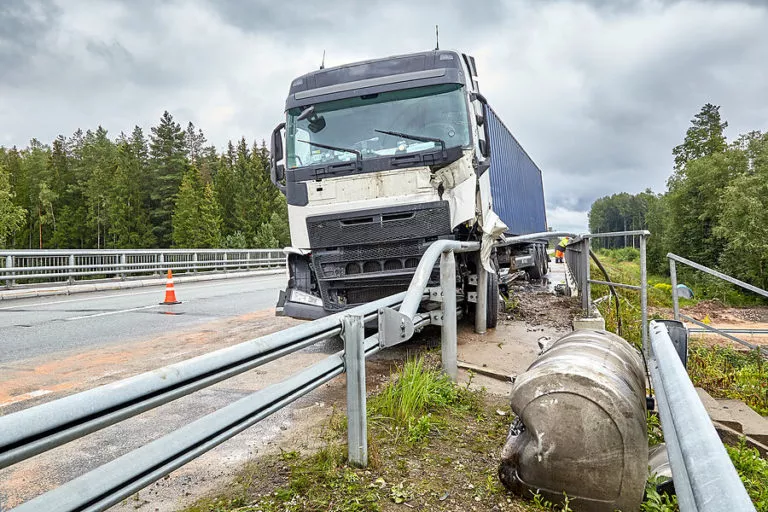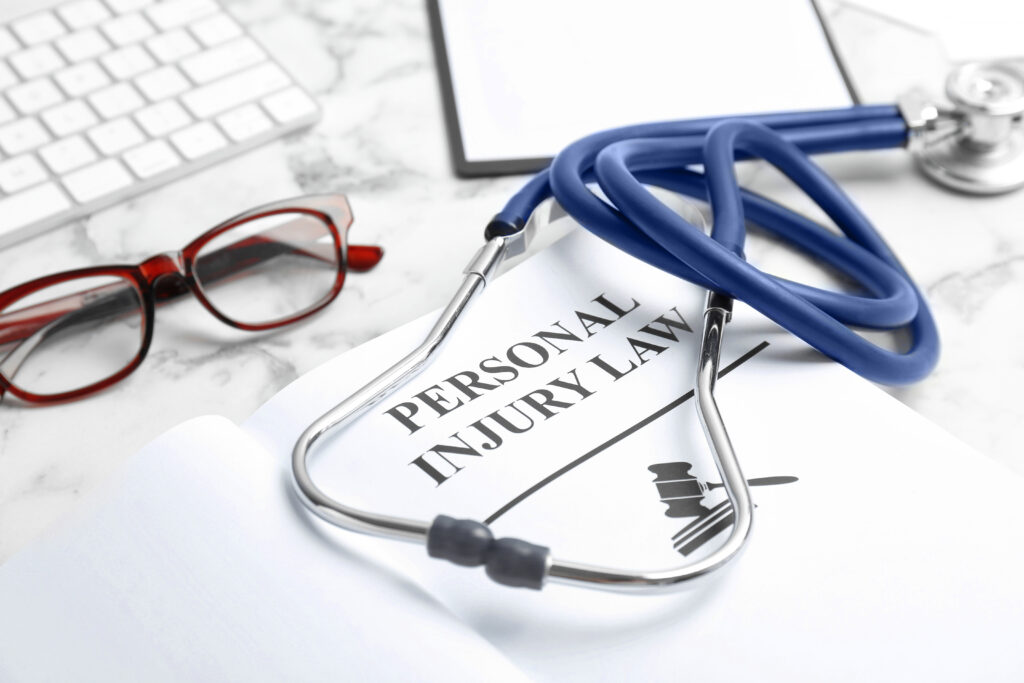A jackknife accident is what happens when a transport truck’s trailer swings out to the side, folding toward the cab in a shape that resembles a pocketknife. These incidents are violent, destructive, and can change your life in an instant. The physics involved mean that once a jackknife begins, it is nearly impossible for the driver to regain control, leading to collisions that involve multiple vehicles and catastrophic damage.
If you’ve been hurt in a jackknifing truck accident in Alberta, the path forward may seem unclear. An experienced Edmonton truck accident lawyer at MNH Injury Lawyers is here to help. Call us at (888) 664-5298 for a no-charge consultation.
GET YOUR FREE CONSULTATION NOW!
Why Do Transport Trucks Jackknife?

A jackknife accident is almost always a story of momentum and friction—or a sudden lack of it. It begins when the drive wheels on the truck’s tractor lock up, but the trailer’s wheels keep moving. The trailer, which can weigh tens of thousands of kilograms, continues its forward motion, pushing it out and around the point of articulation. This uncontrolled swing is the “jackknife.”
Several distinct factors, in combination, typically result in this dangerous situation.
Driver Actions (or Inactions)
The person behind the wheel holds significant responsibility for the safe operation of a commercial vehicle. Their decisions—or indecision—can be the primary cause of a loss-of-control event.
Improper Braking:
A leading cause is sudden, hard braking. When a driver slams on the brakes, the tractor’s wheels can lock. The trailer, however, keeps moving forward, creating an unstable angle that quickly becomes unmanageable. Professional drivers are trained in braking techniques to avoid this, but panic or a moment of inattention could lead to a disastrous error.
Speeding:
Travelling too fast for the conditions, especially around curves or on slick roads, dramatically increases the risk. High speed reduces the time a driver has to react to hazards and increases the forces acting on the vehicle, making a loss of traction far more likely.
Inexperience or Inadequate Training:
Operating a commercial vehicle requires a high level of skill. Alberta has specific training and licensing requirements for commercial drivers, but simply having a licence does not guarantee proficiency. A driver without sufficient real-world experience may not know how to properly react to a skid, apply corrective steering, or use the brakes appropriately in an emergency, making a bad situation worse.
Fatigue and Distraction:
Hours-of-service regulations exist to prevent driver fatigue. In Alberta, a driver is generally limited to 13 hours of driving within a work shift. A tired or distracted driver has slower reaction times and is more likely to make a critical error, like misjudging a turn or braking too hard.
External and Equipment-Related Factors
Sometimes, the cause of a jackknife lies beyond the driver’s immediate control, stemming from the vehicle itself or the environment.
Mechanical Failure:
Poorly maintained or faulty brakes are a frequent contributor. If a truck’s brakes are not properly adjusted or have worn components, they can lock up unexpectedly. The trucking industry is heavily regulated, and drivers and companies are required to keep thorough maintenance logs. A failure to do so can point to negligence.
Improper Cargo Loading:
The stability of a transport truck is heavily dependent on its load. An empty, lightly loaded, or unbalanced trailer is much more susceptible to skidding and swinging out of control. This is because there isn’t enough weight on the trailer’s axles to maintain proper traction. If cargo shifts during transit because it was not secured correctly, it might suddenly alter the vehicle’s centre of gravity and initiate a jackknife.
Road and Weather Conditions:
Rain, ice, snow, or even high winds can reduce the traction needed to keep a trailer stable and in line with the cab. While a driver cannot control the weather, they are expected to adjust to it. Professional drivers are held to a higher standard and must reduce speed and increase following distance in hazardous conditions.
Who Is Held Responsible When a Truck Jackknifes in Alberta?
It’s rarely as simple as just blaming the driver. In Alberta, a thorough investigation may reveal that several parties could be held liable for the harm you have suffered. The investigation process involves identifying all potential defendants and proving their role in causing the incident.
The Concept of Negligence
The foundation of a personal injury claim rests on the legal concept of negligence. In simple terms, negligence is the failure to use reasonable care, which results in damage or injury to another person.
To make a successful claim, our lawyers must show that a party owed you a duty of care, they breached that duty through their actions or inactions, and this breach directly caused the injuries and losses you sustained.
Parties That May Be Liable
In the context of a commercial trucking accident, the net of responsibility can be cast wide, often extending beyond the individual behind the wheel.
The Truck Driver: The most obvious party is the driver. If the driver was speeding, distracted, impaired, or otherwise driving carelessly, they can be found negligent for breaching their duty to operate their vehicle safely.
The Trucking Company: Employers can be held responsible for the negligent acts of their employees through a legal principle called vicarious liability. This means if the driver caused the accident while performing their job-related duties, the company that employs them can be held responsible. A company may also be directly negligent for its own failures, such as:
- Failing to provide adequate driver training and supervision.
- Pressuring drivers to violate hours-of-service regulations, which leads to fatigue.
- Failing to properly maintain their fleet of vehicles, leading to equipment failures.
- Negligent hiring practices, such as employing a driver with a poor safety record.
Third Parties: In some cases, other entities may share the blame for creating the conditions that led to the jackknife accident. This could include:
- Cargo Loaders: If the cargo was improperly loaded or secured by a separate company, making the trailer dangerously unstable.
- Mechanics or Maintenance Shops: If they performed faulty repairs on the truck’s brakes or other essential systems, that failure could be a direct cause of the crash.
- Vehicle or Parts Manufacturers: If a defect in the truck’s design or a specific component, like the braking system, contributed to the loss of control.
What Are Your Rights After a Jackknifing Truck Accident?
In Alberta, you have access to immediate benefits, and you also have the right to pursue a claim for compensation against the at-fault parties.
First Steps: Section B “No-Fault” Benefits
Every auto insurance policy in Alberta includes Section B benefits, as mandated by the Insurance Act. These are available to you through your own insurance policy, regardless of who was at fault for the accident. They are also called “no-fault” benefits for this reason.
What they cover: Section B provides coverage for medical and rehabilitation expenses up to a maximum of $50,000 per person. This includes services like physiotherapy, massage therapy, chiropractic care, and psychological counselling. Because the provincial health service covers your hospital and physician bills, these benefits are used for treatments that are not covered by Alberta Health Care.
Disability Benefits: If you are unable to work due to your injuries, Section B also provides income replacement. This is calculated at 80% of your gross weekly earnings, up to a maximum of $600 per week, for up to 104 weeks. There is no payment for the first 7 days of disability; benefits only begin after this waiting period.
The Tort Claim: Seeking Full Compensation

While Section B provides immediate support, it rarely covers the full extent of your losses in a serious accident. A separate legal action, known as a tort claim, is how we pursue full and fair compensation from the at-fault trucking company and its insurer. This claim is intended to make you “whole” again, as much as money can, by compensating you for all the ways the accident has impacted your life.
What this claim covers:
- Pain and Suffering: Compensation for the physical pain, emotional distress, and loss of enjoyment of life your injuries have caused.
- Loss of Income (Past and Future): The difference between what Section B provides and your actual lost income, as well as the earnings you are likely to lose in the future if you cannot return to work or must take a lower-paying job.
- Cost of Future Care: The funds needed for any ongoing medical treatment, therapy, medication, home modifications, or personal assistance you may require for the rest of your life.
- Out-of-Pocket Expenses: Reimbursement for any other costs you have incurred, such as damaged property, travel for medical appointments, or medication costs not covered by other plans.
A Note on the Minor Injury Regulation (MIR)
The Alberta government has placed a cap on pain and suffering damages for certain injuries defined as “minor.” This is known as the Minor Injury Regulation (MIR). It typically applies to some sprains, strains, and whiplash-associated disorders (WAD).
However, whether an injury truly falls under the MIR cap depends on whether it results in a “serious impairment” that substantially affects your ability to work or perform your normal daily activities. An injury that seems minor at first but leads to chronic pain, psychological issues, or long-term disability may not be subject to the cap. Determining if the MIR applies to your situation is a difficult legal question that requires a careful analysis of your medical records and the functional impact of your injuries. It is best to have a lawyer review your case to ensure your rights are protected and you are not unfairly limited by the cap.
Frequently Asked Questions About Jackknife Truck Accidents
Professional truck drivers are held to a higher standard of care and are required by law and training to adjust their driving for poor weather conditions. Simply blaming ice or rain is usually not a valid defence if they were driving too fast or failed to take appropriate precautions for those conditions.
Yes. An empty or lightly loaded trailer can actually be more dangerous because the wheels are more likely to lock up and skid during braking due to insufficient traction.
Yes. Alberta uses a system of comparative fault. This means you can still receive compensation even if you were partially to blame for the collision. Your final settlement would simply be reduced by your percentage of fault, as determined by the court.
You should not sign any documents, provide a detailed recorded statement, or accept any money from the other party’s insurer without first speaking to a lawyer.
Let Us Handle the Road Ahead

A jackknife truck accident creates chaos and uncertainty. You do not have to face it alone. Our lawyers at MNH Injury Lawyers understand the complexities of trucking regulations and personal injury law in Alberta. An experienced Edmonton personal injury lawyer from our team is ready to handle the legal burdens so you can focus on what matters most—your health and your family.
If you or a loved one has been injured in a jackknifing truck accident, call us today for a free, no-obligation consultation. We will help you understand your rights and options.
Contact MNH Injury Lawyers at (888) 664-5298.
